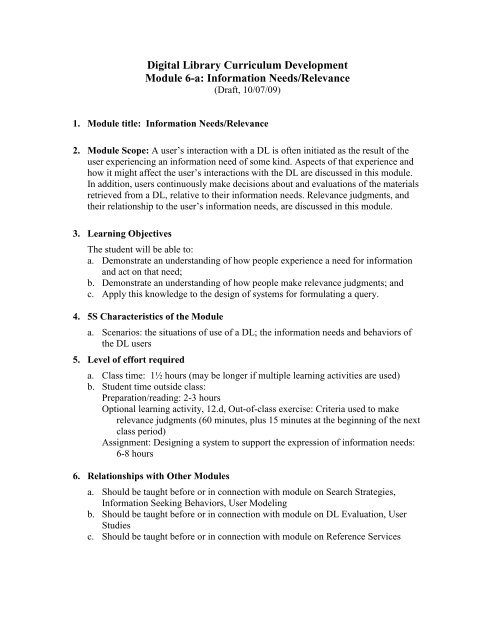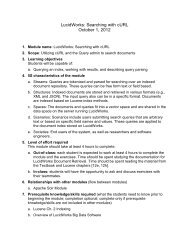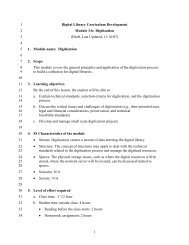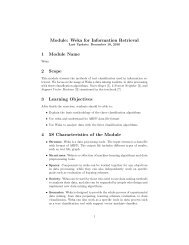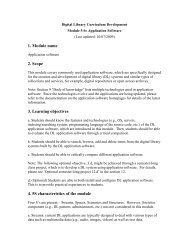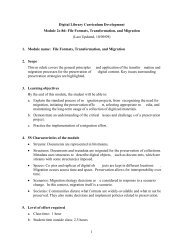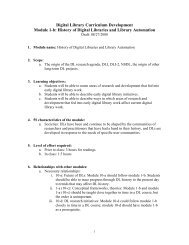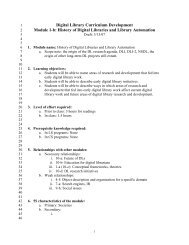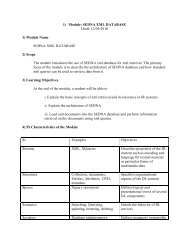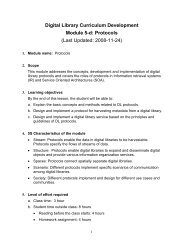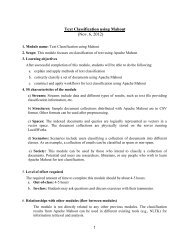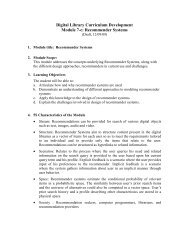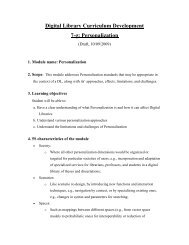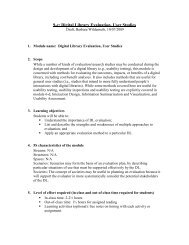Template for DL Instructional Modules - Digital Library Curriculum ...
Template for DL Instructional Modules - Digital Library Curriculum ...
Template for DL Instructional Modules - Digital Library Curriculum ...
You also want an ePaper? Increase the reach of your titles
YUMPU automatically turns print PDFs into web optimized ePapers that Google loves.
<strong>Digital</strong> <strong>Library</strong> <strong>Curriculum</strong> DevelopmentModule 6-a: In<strong>for</strong>mation Needs/Relevance(Draft, 10/07/09)1. Module title: In<strong>for</strong>mation Needs/Relevance2. Module Scope: A user’s interaction with a <strong>DL</strong> is often initiated as the result of theuser experiencing an in<strong>for</strong>mation need of some kind. Aspects of that experience andhow it might affect the user’s interactions with the <strong>DL</strong> are discussed in this module.In addition, users continuously make decisions about and evaluations of the materialsretrieved from a <strong>DL</strong>, relative to their in<strong>for</strong>mation needs. Relevance judgments, andtheir relationship to the user’s in<strong>for</strong>mation needs, are discussed in this module.3. Learning ObjectivesThe student will be able to:a. Demonstrate an understanding of how people experience a need <strong>for</strong> in<strong>for</strong>mationand act on that need;b. Demonstrate an understanding of how people make relevance judgments; andc. Apply this knowledge to the design of systems <strong>for</strong> <strong>for</strong>mulating a query.4. 5S Characteristics of the Modulea. Scenarios: the situations of use of a <strong>DL</strong>; the in<strong>for</strong>mation needs and behaviors ofthe <strong>DL</strong> users5. Level of ef<strong>for</strong>t requireda. Class time: 1½ hours (may be longer if multiple learning activities are used)b. Student time outside class:Preparation/reading: 2-3 hoursOptional learning activity, 12.d, Out-of-class exercise: Criteria used to makerelevance judgments (60 minutes, plus 15 minutes at the beginning of the nextclass period)Assignment: Designing a system to support the expression of in<strong>for</strong>mation needs:6-8 hours6. Relationships with Other <strong>Modules</strong>a. Should be taught be<strong>for</strong>e or in connection with module on Search Strategies,In<strong>for</strong>mation Seeking Behaviors, User Modelingb. Should be taught be<strong>for</strong>e or in connection with module on <strong>DL</strong> Evaluation, UserStudiesc. Should be taught be<strong>for</strong>e or in connection with module on Reference Services
6-a: In<strong>for</strong>mation Needs, RelevancePage 27. Prerequisite Knowledge RequiredNone8. Introductory Remedial InstructionNone9. Body of KnowledgeWilson’s model of in<strong>for</strong>mation behaviors (**Graphic: Wilson, 1997, Figure 1)Context of in<strong>for</strong>mation needPerson-in-contextSituational; supports Dervin’s workTypes of needs (Weigts et al., 1993)Need <strong>for</strong> new in<strong>for</strong>mationNeed to clarify in<strong>for</strong>mation already heldNeed to confirm in<strong>for</strong>mation already heldNeed to clarify beliefs/values heldNeed to confirm beliefs/values heldStress and coping theory precipitate actionCoping = cognitive and behavioral effects to master, reduce or tolerate theinternal and external demands that are created by stressful situations(Folkman & Lazarus, 1985)Perceived stress will lead to coping behaviors, including in<strong>for</strong>mationseekingIntervening variables may be barriers to or instigators of actionPsychological: cognitive dissonance, attention, avoidance of painDemographic: educational level, economic statusRole-related or interpersonal: attitude of the in<strong>for</strong>mation provider,presence of others during the in<strong>for</strong>mation behavior, provider’sunwillingness to share in<strong>for</strong>mationEnvironmental/situational barriers: lack of time, interruptions, geographiclocation, power distribution not equitable, cultural normsIn<strong>for</strong>mation source characteristics: accessibility, credibility
6-a: In<strong>for</strong>mation Needs, RelevancePage 3Activating mechanisms that are proximate to in<strong>for</strong>mation seeking behaviorRisk/reward theory: each decision to act will be influenced by the risksassociated with acting/not acting, and the rewards <strong>for</strong> acting/not actingSelf-efficacy: each decision to act will be influence by the potentialactor’s beliefs about whether s/he can successfully achieve the desiredoutcomeOne aspect of social learning theoryIn<strong>for</strong>mation seeking behaviorPassive attention to in<strong>for</strong>mation in the environment, e.g., recognizinglandmarks when navigatingPassive search <strong>for</strong> in<strong>for</strong>mation, e.g., daily reading of the newspaper <strong>for</strong>in<strong>for</strong>mation pertinent to personal daily lifeActive search <strong>for</strong> in<strong>for</strong>mation, e.g., doing an online searchOngoing search <strong>for</strong> in<strong>for</strong>mation, e.g., regular scanning of tables ofcontentsIn<strong>for</strong>mation processing and useRetrieval is not the end of the process; the in<strong>for</strong>mation retrieved is used insome wayThe result is the context of in<strong>for</strong>mation need <strong>for</strong> the next cycleLessons learned from Wilson’s modelAn in<strong>for</strong>mation need involves more than just a lack of needed in<strong>for</strong>mationContext, affective responses to the situation, intervening variables,activating mechanismsWhen an in<strong>for</strong>mation need is experienced, it is likely that in<strong>for</strong>mationseeking will be undertaken**If desired, use learning activity 12.a, Discussion activity: Personal experiences of anin<strong>for</strong>mation need (25 minutes)
6-a: In<strong>for</strong>mation Needs, RelevancePage 4Anomalous state of knowledge (ASK) – Belkin (1980)**Graphic: Belkin, 1980, Figure 2AssumptionsThe IR situation is a communication systemThe mediating role of the participants is a primary determinant ofsuccess/failureRepresenting users’ needs is as important as representing texts <strong>for</strong> thesuccess of the systemConceptual state of knowledge: each person has knowledge; that body ofknowledge moves from state to state as in<strong>for</strong>mation is acquired and usedOne possible state is the anomalous state of knowledgeAnomalies can be gaps/lacks, uncertainties, incoherenceThe user realizes his/her in<strong>for</strong>mation need and so finds him/herself in ananomalous state of knowledge, which is then trans<strong>for</strong>med into arequestLessons to be learned from Belkin’s workAn anomalous state of knowledge is the primary motivator of in<strong>for</strong>mationseeking behaviorsDifficulties can arise during the in<strong>for</strong>mation retrieval process because it isdifficult or impossible <strong>for</strong> someone to specify a query when theirknowledge state is anomalousIn<strong>for</strong>mation needs (Taylor, 1968)Levels of in<strong>for</strong>mation need and how they relate to Belkin’s modelVisceral needActual, but unexpressedConscious, or possibly unconscious needInexpressible in linguistic termsConscious needIll-defined area of indecision; Ambiguous, ramblingConversation about the need may reduce ambiguityFormalized needFormal statement of the needExplicitly expressedCompromised needAs presented to the in<strong>for</strong>mation systemThe librarian may be part of the in<strong>for</strong>mation system, in theuser’s viewRestated, to accommodate the characteristics of the in<strong>for</strong>mationsystem: indexing structure, <strong>for</strong>mat/medium of in<strong>for</strong>mationobjects
6-a: In<strong>for</strong>mation Needs, RelevancePage 5Assumptions underlying this frameworkLibraries should be communication centers, rather than passivewarehousesA particular inquiry “is merely a micro-event in a shifting non-linearadaptive mechanism”Lessons learned from Taylor’s workThe inquirer has already gone through several stages be<strong>for</strong>e approachingthe librarian or <strong>DL</strong>It is likely that the inquirer will have difficulty expressing a query (i.e.,expressing a compromised need) in a <strong>for</strong>m that will result in successfulretrieval (in agreement with Belkin’s view)Relevance judgments and their relation to in<strong>for</strong>mation needsThe in<strong>for</strong>mation needs experienced at the beginning of the process, along with thecharacteristics of the user, are reflected in the relevance judgments made nearthe end of the processMaking relevance judgments about retrieved documents is based onwhether they satisfy the in<strong>for</strong>mation needVarious types of relevance (Sarcevic, 2006; Borlund, 2003)System/algorithmic relevanceTopical/subject relevanceThe one most often though ofCognitive relevance or pertinenceSituational relevance or utilityThe subjective nature of relevance judgments make them difficult toincorporate realistically into IR experiments, but most definitions ofrelevance judgments do consider them to be subjective and/or specificto the user’s situationWhile topicality is a primary consideration as people make relevance judgments,they also take into account other aspects of the document and its relation tothe situation (Yuan et al., 2002)Novelty: uniqueness of the source; the user’s familiarity with the source(negative)Currency: whether the source is up to dateQuality of the in<strong>for</strong>mation the source providesThe presentation and comprehensiveness of the in<strong>for</strong>mationOther aspects of the source, e.g., that the source is well known in the fieldIn<strong>for</strong>mation aspects of the source, e.g., that it describes treatments ortechniques or provides examplesAppeal: whether the source is interesting or enjoyable
6-a: In<strong>for</strong>mation Needs, RelevancePage 6There are a variety of ways that <strong>DL</strong> design can support the articulation of in<strong>for</strong>mation needsBrowsing support: when the query cannot be readily specifiedExamples:Previews and overviews of a large collection: <strong>Library</strong> of CongressAmerica Memory Project (Collection Finder).http://memory.loc.gov/ammem/collections/finder.htmlDynamic Queries Demos, available via the Open Video Repository.http://www.open-video.org/details.php?videoid=709Hyperbolic browser: Inxight VizServer (<strong>for</strong>merly Star Tree). OnlineDemos available in right column.http://www.inxight.com/products/vizserver/Relevance feedback: using the in<strong>for</strong>mation in a relevance judgment to implicitlyspecify the queryExamples:Google, “Similar pages” link with each retrieved documentScatter/gather approach to IR: Hearst, M. (n.d.) A scatter/gather example.http://people.ischool.berkeley.edu/~hearst/research/scattergather.htmlPersonalization: modifying the system features to match the user’s mode ofin<strong>for</strong>mation seekingExamples:My<strong>Library</strong>, NC State University, http://www.lib.ncsu.edu/mylibrary/My<strong>Library</strong>, Los Alamos National Laboratory,http://library.lanl.gov/lww/mylibweb.htm**If desired, used learning activity 12.b, Brainstorming/discussion activity: Observableindicators of an in<strong>for</strong>mation need (20 minutes), or 12.c, Design exercise: Designing asystem to support the expression of in<strong>for</strong>mation needs (40 minutes)**If desired, assign learning activity 12.d, Out-of-class exercise: Criteria used to makerelevance judgments, <strong>for</strong> completion after this class session (60 minutes, plus 15minutes at the beginning of the next class period)10. Resourcesa. Readings to be assignedCase, D. O. (2002). In<strong>for</strong>mation needs and in<strong>for</strong>mation seeking. In Looking <strong>for</strong>In<strong>for</strong>mation: A Survey of Research on In<strong>for</strong>mation Seeking, Needs, and Behavior.Amsterdam: Academic Press, 64-78.Belkin, N. J. (1980). Anomalous states of knowledge as a basis <strong>for</strong> in<strong>for</strong>mation retrieval.Canadian Journal of In<strong>for</strong>mation Science, 5, 133-143.
6-a: In<strong>for</strong>mation Needs, RelevancePage 7Saracevic, T. (2006). Relevance: A review of the literature and a framework <strong>for</strong>thinking on the notion in in<strong>for</strong>mation science. Part II. In Advances inLibrarianship, 30, 3-71. [Assign Section VI. Models of relevance: Howrelevance was reviewed and reviewed, and how a few models came out ofreviews, 21-30.]Taylor, R. S. (1968). Question-negotiation and in<strong>for</strong>mation seeking in libraries. College& Research Libraries, 29(3), 178-194.Wilson, T. D. (1997). In<strong>for</strong>mation behaviour: An interdisciplinary perspective.In<strong>for</strong>mation Processing & Management, 33(4), 551-572.b. Additional supporting references on in<strong>for</strong>mation needsDervin, B. (1983). In<strong>for</strong>mation as a user construct: The relevance of perceivedin<strong>for</strong>mation needs to synthesis and interpretation. In Ward, S. A., & Reed, L. J. (eds.),Knowledge Structure and Use: Implications <strong>for</strong> Synthesis and Interpretation,Philadelphia: Temple University Press, 153-183.Folkman, S., & Lazarus, R.S. (1985). If it changes it must be a process: Study ofemotion and coping during three stages of a college examination. Journal ofPersonality and Social Psychology, 48(1), 150-170.Frants, V. I., & Brusch, C. B. (1988). The need <strong>for</strong> in<strong>for</strong>mation and some aspects ofin<strong>for</strong>mation retrieval systems construction. Journal of the American Society <strong>for</strong>In<strong>for</strong>mation Science, 39(2), 86-91.Hert, C. A. (1996). User goals on an online public catalog. Journal of the AmericanSociety <strong>for</strong> In<strong>for</strong>mation Science, 47(7), 504-518.Markey, K. (1981). Levels of question <strong>for</strong>mulation in negotiation of in<strong>for</strong>mation needduring the online presearch interview: A proposed model. In<strong>for</strong>mation Processing &Management, 17(5), 215-225.Weigts, W.; Widdershoven, G.; Kok, G.; Tomlow, P. (1993). Patients’ in<strong>for</strong>mationseeking actions and physicians’ responses in gynaecological consultations.Qualitative Health Research, 3, 398-429.c. Additional supporting references on relevanceBarry, C.L. (1994). User-defined relevance criteria: An exploratory study. Journal of theAmerican Society <strong>for</strong> In<strong>for</strong>mation Science, 45(3), 149-159.Borlund, P. (2003). The concept of relevance in IR. Journal of the American Society <strong>for</strong>In<strong>for</strong>mation Science & Technology, 54(10), 913-925.Cooper, W.S. (1973). On selecting a measure of retrieval effectiveness, part I: The“subjective” philosophy of evaluation. Journal of the American Society <strong>for</strong>In<strong>for</strong>mation Science, 24, 87-100.Cosijn, E., & Ingwersen, P. (2000). Dimensions of relevance. In<strong>for</strong>mation Processing &Management, 36(4), 533-550.Greisdorf, H. (2003). Relevance thresholds: A multi-stage predictive model of how usersevaluate in<strong>for</strong>mation. In<strong>for</strong>mation Processing & Management, 39(3), 403-423.Harter, S.P. (1992). Psychological relevance and in<strong>for</strong>mation science. Journal of theAmerican Society <strong>for</strong> In<strong>for</strong>mation Science, 43(9), 602-615.Mizzaro, S. (1997). Relevance: The whole history. Journal of the American Society <strong>for</strong>In<strong>for</strong>mation Science, 48(9), 810-832.Park, T.K. (1993). The nature of relevance in in<strong>for</strong>mation retrieval: An empirical study.<strong>Library</strong> Quarterly, 63(3), 318-351.
6-a: In<strong>for</strong>mation Needs, RelevancePage 8Schamber, L., Eisenberg, M.B., & Nilan, M.S. (1990). A re-examination of relevance:Toward a dynamic, situational definition. In<strong>for</strong>mation Processing & Management,26(6), 755-776.Swanson, D.R. (1986). Subjective versus objective relevance in bibliographic retrievalsystems. <strong>Library</strong> Quarterly, 56(4), 389-398.Wang, P., & Soergel, D. (1998). A cognitive model of document use during a researchproject. Study I. Document selection. Journal of the American Society <strong>for</strong>In<strong>for</strong>mation Science, 49(2), 115-133.Wilson, P. (1973). Situational relevance. In<strong>for</strong>mation Storage & Retrieval, 9(8), 457-471.Yuan, X.-J., Belkin, N. J., & Kim, J.-Y. (2002). The relationship between ASK andrelevance criteria. Proceedings of SIGIR 2002, 359-360.11. Concept MapNone12. Exercises/Learning Activitiesa. Discussion activity: Personal experiences of an in<strong>for</strong>mation need (25 minutes)To follow the review of Wilson’s generalized model of in<strong>for</strong>mation behaviorStudents in the class should be <strong>for</strong>med into pairs. In each pair, one student willinterview the other. (This process should later be repeated, reversing roles.) Theperson being interviewed should be asked to recall a recent experience of havingan in<strong>for</strong>mation need. The need may have been something significant (e.g.,finding sources to use <strong>for</strong> a research project) or something inconsequential (e.g.,finding the start time <strong>for</strong> Saturday’s football game). The interviewer should askabout the content of the in<strong>for</strong>mation need, the context in which it arose, and theprocess through which it was pursued (successfully or unsuccessfully). The pairshould then evaluate what was learned about this example of an in<strong>for</strong>mation needand see if Wilson’s model fully describes the process. Were there aspects of thein<strong>for</strong>mation-seeking episode that are not covered in Wilson’s model? Are thereaspects of Wilson’s model that did not occur during this in<strong>for</strong>mation-seekingepisode?b. Brainstorming/discussion activity: Observable indicators of an in<strong>for</strong>mation need(20 minutes)To follow discussion of Taylor’s levels of needs, or at the end of the class periodAn in<strong>for</strong>mation need is experienced in an individual’s consciousness. But at somepoint, if the person decides to pursue it, there are observable indicators that a needhas been experienced.Form the students into small groups of 2-3 people. Each group should get 10minutes to brainstorm as many indicators of in<strong>for</strong>mation needs as possible. Theymay include those they’ve observed, those they’ve enacted, or others they canimagine.
6-a: In<strong>for</strong>mation Needs, RelevancePage 9At the end of the 10 minute brainstorming period, ask each group to share severalof those they listed, including one indicator that they believe is frequentlyobservable, one that is rare, and one that has possible implications <strong>for</strong> digitallibrary design.c. Design exercise: Designing a system to support the expression of in<strong>for</strong>mationneeds (40 minutes)To follow discussion of Taylor’s levels of needs, or at the end of the class periodDivide the class into design teams of 3-4 students each. Each team will develop arough (i.e., paper-and-pencil) prototype of a <strong>DL</strong> interface that will specificallyfocus on assisting the user in successfully “compromising” the in<strong>for</strong>mation need.Because the system designs may be targeted to particular <strong>DL</strong>s and their users,each of the following situations can be distributed to a different team:The <strong>DL</strong> will provide access to a collection of Eastern European historyjournals <strong>for</strong> historians across Europe, working on projects with fundingfrom the European Union. The projects are most often focused onunderstanding the cultural and social history of the region during the 14 th -18 th centuries.The <strong>DL</strong> will provide access to social science statistical data gatheredthrough federally-funded research. Social scientists whose work issupported by grants from a number of federal agencies, including NSF,now require that they deposit their raw data set and a coding manual <strong>for</strong> itin this <strong>DL</strong>. It is expected that other researchers will be able to retrieve datafrom this <strong>DL</strong> <strong>for</strong> secondary analysis or <strong>for</strong> comparative studies.The <strong>DL</strong> is a joint ef<strong>for</strong>t by a number of natural history museums and willeventually provide access to images, videos, and text related to all theanimals and plants of the world. It is intended that school children, theirteachers, and the general public will be the primary users of this <strong>DL</strong>. Itwill serve as a general-purpose reference work <strong>for</strong> these audiences.The <strong>DL</strong> will provide access to manuscripts and letters written by slaves inthe U.S. be<strong>for</strong>e the Civil War. It is expected that the primary sourcematerials in the <strong>DL</strong> will be used by history scholars to support theirresearch work.The <strong>DL</strong> will provide access to manuscripts and letters written by slaves inthe U.S. be<strong>for</strong>e the Civil War. It will be used by high school andcommunity college teachers to develop materials they can use in theirclassrooms to teach about slavery during this period.The <strong>DL</strong> will provide access to books, essays, stories, and videos, all inEnglish, from a variety of countries. It will be used by children in grades1-5 to support their schoolwork and their leisure time activities.Note that the design task is NOT to develop a full-scale <strong>DL</strong> interface. Instead, thestudents should focus their attention on developing a way in which the <strong>DL</strong> can
6-a: In<strong>for</strong>mation Needs, RelevancePage 10provide assistance to the intended users in <strong>for</strong>mulating queries, based on theirin<strong>for</strong>mation needs.Allow approximately 20-30 minutes <strong>for</strong> teams to develop their ideas. Be sure tocheck in with them every 5-7 minutes, to respond to questions and to ensure thatthey are still working on the assigned goal rather than getting side-tracked.Each team should draw one screen image on the whiteboard, and briefly describetheir prototype. In particular, they should be encouraged to describe the designdecisions they made and the assumptions underlying those decisions.d. Out-of-class exercise: Criteria used to make relevance judgments (60 minutes,plus 15 minutes at the beginning of the next class session)The students should work in pairs <strong>for</strong> this exercise, so teams should be <strong>for</strong>medbe<strong>for</strong>e the end of the class period.Each member of the class will be both an interviewer and an interviewee, playingeach role in turn. The interviewee will select an assignment that he or she recentlycompleted that involved the use of a <strong>DL</strong> to search <strong>for</strong> relevant materials. With theinterviewer present, the interviewee will complete the search again. For at leastfive of the items retrieved, the interviewee will be asked by the interviewer toexamine all the available document in<strong>for</strong>mation elements and comment on howhe or she came to a decision about whether that document was relevant to theassignment or not. Once the five items have been reviewed, the two students willreverse roles and complete the process again. The second interviewee will selectan assignment that he or she recently completed that involved the use of a <strong>DL</strong>,and will repeat their recent search while being interviewed.Based on the notes taken during the interviews, each student should summarizethe relevance criteria applied by their partner, and the user characteristics anddocument in<strong>for</strong>mation elements that were pertinent to those decisions. A table likethe following could be used <strong>for</strong> reporting these data:Relevance criterion (basedon list in Yuan et al., 2002;Barry, 1994; or Park, 1993)TopicalityPertinent document in<strong>for</strong>mation elementsand user characteristicsDIE: Title of paperDIE: Abstract of paperU: User is just being introduced to the topicNumber ofoccurrences in thefive judgmentsobservedThese results should be reported to the class members and the course instructorbe<strong>for</strong>e the next class period, preferably through direct entry into a class wiki orother collaborative tool.
6-a: In<strong>for</strong>mation Needs, RelevancePage 11During the next class period, the results could be reviewed and compared to theresults found by similar studies (e.g., Barry, 1994; Park, 1993), using anadaptation of the table above <strong>for</strong> integrating the data, as shown here.Relevance criterion(based on list inYuan et al., 2002;Barry, 1994; orPark, 1993)TopicalityPertinent documentin<strong>for</strong>mation elements anduser characteristicsDIE: Title of paperDIE: Abstract of paperU: User is just beingintroduced to the topicTotalnumber ofoccurrencesNumber ofdocumentsin whichcriterionwas usedNumber ofpeople usingthe criterion13. Evaluation of Learning Outcomesa. Design assignment (modified from in-class exercise described in 10.b.):Designing a system to support the expression of in<strong>for</strong>mation needs (6-8 hours)Divide the class into design teams of 2-3 students each. Each team will develop arough (i.e., paper-and-pencil) prototype of a <strong>DL</strong> interface that will specificallyfocus on assisting the user in successfully “compromising” the in<strong>for</strong>mation need.Because the system designs may be targeted to particular <strong>DL</strong>s and their users,each of the following situations can be distributed to a different team:The <strong>DL</strong> will provide access to a collection of Eastern European historyjournals <strong>for</strong> historians across Europe, working on projects with fundingfrom the European Union. The projects are most often focused onunderstanding the cultural and social history of the region during the 14 th -18 th centuries.The <strong>DL</strong> will provide access to social science statistical data gatheredthrough federally-funded research. Social scientists whose work issupported by grants from a number of federal agencies, including NSF,now require that they deposit their raw data set and a coding manual <strong>for</strong> itin this <strong>DL</strong>. It is expected that other researchers will be able to retrieve datafrom this <strong>DL</strong> <strong>for</strong> secondary analysis or <strong>for</strong> comparative studies.The <strong>DL</strong> is a joint ef<strong>for</strong>t by a number of natural history museums and willeventually provide access to images, videos, and text related to all theanimals and plants of the world. It is intended that school children, theirteachers, and the general public will be the primary users of this <strong>DL</strong>. Itwill serve as a general-purpose reference work <strong>for</strong> these audiences.The <strong>DL</strong> will provide access to manuscripts and letters written by slaves inthe U.S. be<strong>for</strong>e the Civil War. It is expected that the primary sourcematerials in the <strong>DL</strong> will be used by history scholars to support theirresearch work.
6-a: In<strong>for</strong>mation Needs, RelevancePage 12The <strong>DL</strong> will provide access to manuscripts and letters written by slaves inthe U.S. be<strong>for</strong>e the Civil War. It will be used by high school andcommunity college teachers to develop materials they can use in theirclassrooms to teach about slavery during this period.The <strong>DL</strong> will provide access to books, essays, stories, and videos, all inEnglish, from a variety of countries. It will be used by children in grades1-5 to support their schoolwork and their leisure time activities.(The instructor may also wish to use an existing <strong>DL</strong>(s) as the basis <strong>for</strong> thisassignment, in order to make the design task more concrete.)Note that the design task is NOT to develop a full-scale <strong>DL</strong> interface. Instead, thestudents should focus their attention on developing a way in which the <strong>DL</strong> canprovide assistance to the intended users in <strong>for</strong>mulating effective queries, based ontheir in<strong>for</strong>mation needs.In addition, each team should document three of their most important designdecisions, providing a rationale <strong>for</strong> each decision. The design decision rationalemay use in<strong>for</strong>mation about the target audience, in<strong>for</strong>mation about the collection,existing design guidelines, existing <strong>DL</strong>s, or research study results as evidence tosupport the decision.Assignment deliverables: (1) An annotated drawing of one screen image,representing the primary interface <strong>for</strong> the query <strong>for</strong>mulation aspect of the <strong>DL</strong>; (2)documentation of three design decisions, including the rationale <strong>for</strong> each.Evaluation rubrics: The assignment should be evaluated based on the quality ofthe proposed design (i.e., its ability to improve the ease and/or clarity with whichthe intended users can express their in<strong>for</strong>mation needs), the quality of the threeindividual design decisions, and the comprehensiveness and quality of theevidence used to support each of the three design decisions.14. GlossaryNo glossary terms needed.15. Additional Useful LinksNone.16. ContributorsBarbara Wildemuth (developer)Christine Borgman, UCLA (evaluator)Boots Cassel, Villanova University (evaluator)Alannah Fitzgerald, Concordia University (evaluator)Gary Marchionini, UNC (evaluator)


